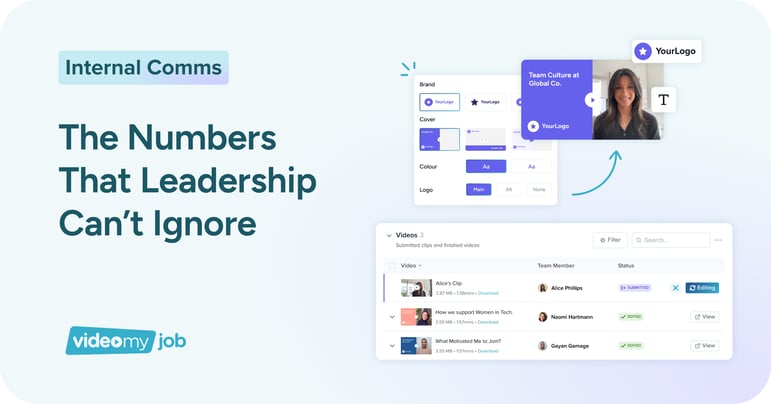“Show me the ROI.”
Four words that strike fear into the heart of every internal communications professional. You know your video-first strategy is working – employees are more engaged, feedback is overwhelmingly positive, and the buzz around company updates has never been stronger. But when it comes to proving concrete business value to senior leadership, many comms teams struggle to move beyond vanity metrics and anecdotal evidence.
The truth is, measuring internal communications impact has always been challenging. But video content offers unprecedented opportunities to track, analyse and demonstrate real business value in ways that traditional text-based communications simply cannot match.

The Business Case for Measuring Internal Communications
Before diving into specific metrics, it’s crucial to understand why measuring internal communications has become a business imperative. Poor internal communication costs organisations an average of $62.4 million annually for companies with 100,000+ employees, whilst companies with highly engaged workforces see 21% higher profitability.
These aren’t just HR statistics. They’re bottom-line business impacts that directly affect your organisation’s competitive position. When you can demonstrate how effective internal communications drive engagement, retention and productivity, you transform from a cost centre into a strategic business function.
The Video Advantage: Why Measurement Matters More Than Ever
Video content provides richer, more actionable data than traditional communication methods. Whilst email analytics might tell you someone opened a message, video analytics reveal exactly how much they watched, where they dropped off and what content resonated most strongly.
This granular data enables continuous improvement and strategic decision-making that was previously impossible. More importantly, it allows you to draw direct connections between communication effectiveness and business outcomes.
Foundation Metrics: The Building Blocks of Impact Measurement
Understanding which metrics truly matter is the first step towards demonstrating ROI. The key is focusing on engagement indicators that directly correlate with business outcomes rather than impressive-sounding numbers that don’t drive decision-making.
Completion rates represent the percentage of viewers who watch your video content from start to finish. This is perhaps the most telling indicator of message effectiveness. Industry benchmarks suggest that internal comms videos should achieve 70-85% completion rates, significantly higher than the 20-30% engagement rates typical of email communications. Track these rates by content type, sender and topic to identify what resonates most with your audience.
Modern video platforms provide second-by-second engagement data, showing exactly where viewers lose interest or replay content. This attention span analysis helps you optimise message structure, identify the most effective content types and understand your audience’s attention patterns. A CEO update with 90% completion rates suggests strong leadership connection, whilst a policy update with 40% completion might indicate the need for a different approach.
Interactive engagement through comments, reactions and shares provides qualitative context to quantitative metrics. Content that sparks discussion demonstrates genuine engagement and message resonance, moving beyond passive consumption towards active participation in company dialogue.
Advanced Analytics: Connecting Communication to Business Impact
The real value lies in connecting communication metrics to measurable business outcomes. This is where video communications truly shine compared to traditional methods.
For training or policy communications, implement follow-up assessments to measure actual knowledge retention. Video content typically achieves considerably higher retention rates than text-based materials. Track how quickly employees adopt new policies or procedures after video communications – faster adoption rates indicate more effective message delivery and comprehension. Or you could monitor whether using video explanations reduce follow-up questions and help desk tickets.
Cultural impact can be measured through regular employee Net Promoter Score (eNPS) surveys to establish a correlation between communication effectiveness and overall employee satisfaction. Companies with highly effective internal communications typically see higher employee engagement scores. Use AI-powered sentiment analysis tools to assess employee comments and reactions to your video content, tracking positive sentiment trends that indicate successful message delivery.
Calculating ROI: Quantifying the Business Impact
The most compelling measurement framework demonstrates direct cost savings and value creation. Calculate time saved by replacing lengthy meetings with concise video updates. If a 60-minute all-hands meeting can be replaced with a 10-minute video update, multiply the time saved by your average hourly employee cost to determine direct savings.
Measure the reduction in training time and associated costs when using video-based onboarding and development materials. Video training typically reduces time-to-competency by 40-60%, representing significant savings in both direct training costs and productivity during the learning period.
Track productivity improvements following effective internal communications – employee productivity increases by 20-25% in organisations where employees are connected. Or, you could focus on the cost savings from improved employee retention. Poor communication typically leads to higher turnover rates, with each retained employee saving recruitment and onboarding costs.
Building Your Measurement Framework
Establishing an effective measurement system requires a phased approach. Begin by establishing baseline metrics for your current approach, including email open rates, meeting attendance, employee satisfaction scores and existing productivity indicators.
Launch your video communication strategy with a small pilot group and establish specific KPIs. Focus on completion rates, engagement metrics and immediate feedback to refine your approach before scaling across the organisation.
Then, as you expand video communications, you can also expand your data tracking to capture both quantitative metrics and qualitative feedback. Develop quarterly and annual reporting that connect communication effectiveness to broader business objectives and strategic goals.
Making the Business Case to Leadership
When presenting ROI data to senior leadership, focus on clear connections between communication metrics and business outcomes. Emphasise specific cost savings and efficiency gains, provide comparative analysis with previous communication methods and offer future investment recommendations based on performance data.
Tailor your measurement reports to different audiences. HR leaders want to see engagement and retention metrics, finance teams need cost savings and efficiency gains, operations managers value productivity improvements and process adoption, whilst C-suite executives want to understand how communication effectiveness connects to strategic objectives.
The Continuous Improvement Advantage
Effective measurement isn’t a one-time activity – it’s an ongoing cycle of analysis, optimisation and refinement. Use your data to identify the most effective content types and formats, optimise message timing and distribution strategies, refine targeting and personalisation approaches and demonstrate ongoing value to maintain investment support.
Companies that effectively measure internal communications don’t just justify their investment. They gain strategic advantages through deeper workforce understanding, improved message effectiveness and stronger business alignment. Modern video platforms make this level of measurement and analysis more accessible than ever, providing the tools and insights needed to transform internal communications from a necessary expense into a measurable business driver.
The question isn’t whether you can afford to measure your internal communications impact, it’s whether you can afford not to. Start measuring today. Your bottom line depends on it.
Ready to transform your internal comms strategy with genuinely engaging video content? Book a demo and discover why VideoMyJob is trusted by leading Talent and Communications teams around the world.
.png?width=200&height=50&name=Untitled%20design%20(21).png)



